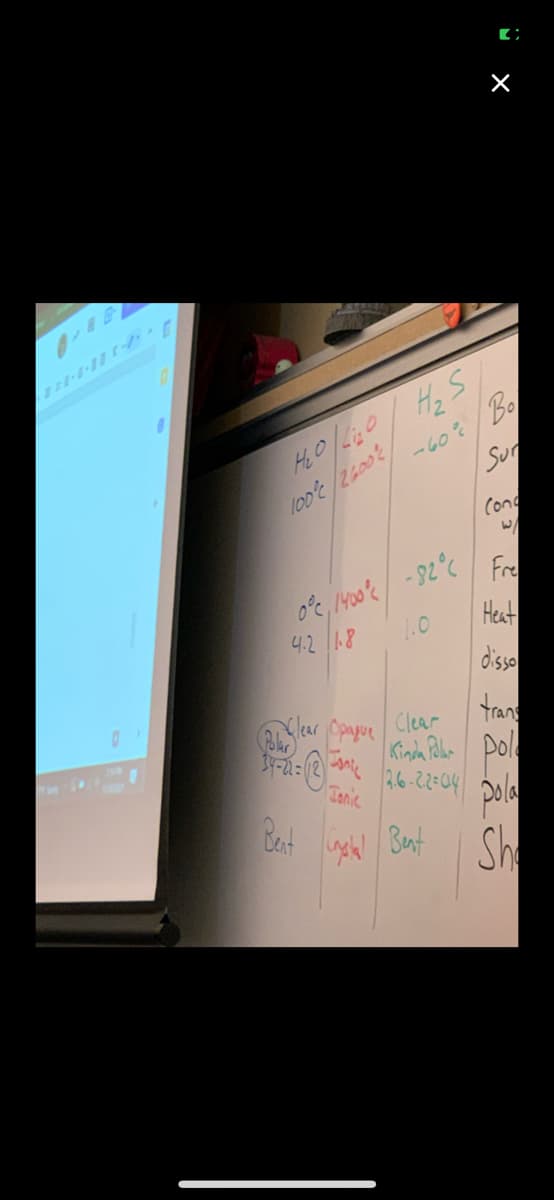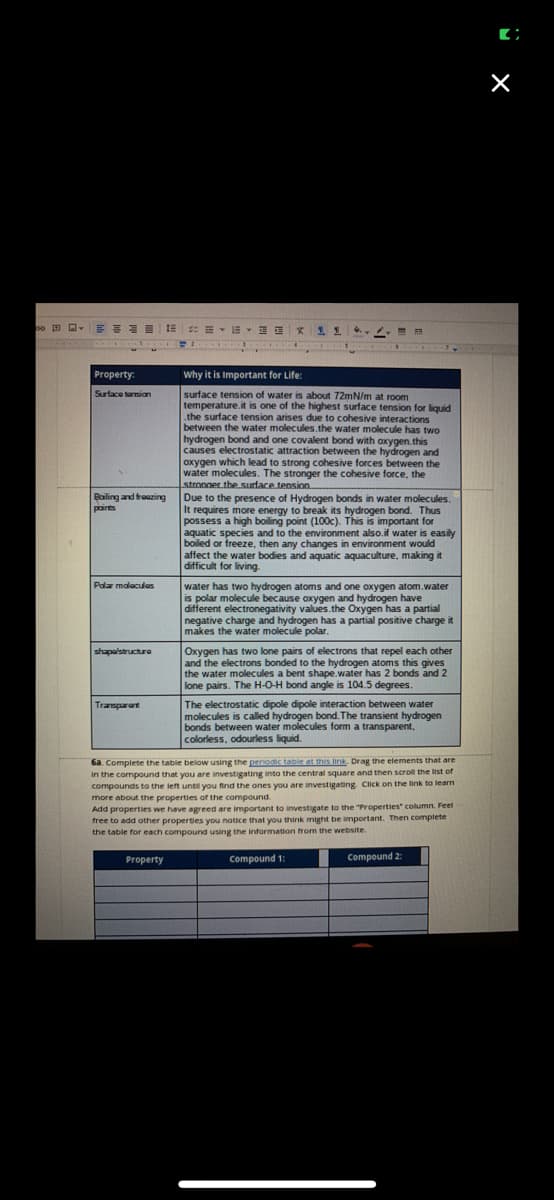Principles of Instrumental Analysis
7th Edition
ISBN:9781305577213
Author:Douglas A. Skoog, F. James Holler, Stanley R. Crouch
Publisher:Douglas A. Skoog, F. James Holler, Stanley R. Crouch
Chapter23: Potentiometry
Section: Chapter Questions
Problem 23.12QAP: What arc the advantages of microfabricated ISEs? Describe typical applications of this type of...
Related questions
Question
Search on google ptable.com… and do question 6a tell me the property and compound 1 and 2 please do it for me don’t return the question ?

Transcribed Image Text:-60
Bo
Sun
H00
looe /26002
cond
- 92
Heat
disso
Fre
o°c, 1y00%
4.2 18
1.0
tran
Kinh Pl Pol
26-22-04
Jonic
pola
Bast
She
Batt

Transcribed Image Text:* E- E - E x 1 1.
Property:
Why it is Important for Life:
Surface tarsian
surface tension of water is about 72mN/m at room
temperature.it is one of the highest surface tension for liquid
.the surface tension arises due to cohesive interactions
between the water molecules.the water molecule has two
hydrogen bond and one covalent bond with oxygen.this
causes electrostatic attraction between the hydrogen and
oxygen which lead to strong cohesive forces between the
water molecules. The stronger the cohesive force, the
stronger.the.Surtace.tension
Due to the presence of Hydrogen bonds in water molecules.
It requires more energy to break its hydrogen bond. Thus
possess a high boiling point (100c). This is important for
aquatic species and to the environment also.if water is easily
boiled or freeze, then any changes in environment would
affect the water bodies and aquatic aquaculture, making it
difficult for living.
Baling and froazing
paints
Polar molocules
water has two hydrogen atoms and one oxygen atom.water
is polar molecule because oxygen and hydrogen have
different electronegativity values.the Oxygen has a partial
negative charge and hydrogen has a partial positive charge it
makes the water molecule polar.
Oxygen has two lone pairs of electrons that repel each other
and the electrons bonded to the hydrogen atoms this gives
the water molecules a bent shape.water has 2 bonds and 2
lone pairs. The H-O-H bond angle is 104.5 degrees.
shapalstructure
Transparent
The electrostatic dipole dipole interaction between water
molecules is called hydrogen bond. The transient hydrogen
bonds between water molecules form a transparent,
colorless, odourless liquid.
6a. Complete the table below using the periodic table at this Iink. Drag the elements that are
in the compound that you are investigating into the central square and then scrol the list of
compounds to the left until you find the ones you are investigating. Click on the link to learn
more about the properties of the compound.
Add properties we have agreed are important to investigate to the "Properties" column. Feel
free to add other properties you notice that you think might be important. Then complete
the table for each compound using the information from the website.
Property
Compound 1:
Compound 2:
Expert Solution
This question has been solved!
Explore an expertly crafted, step-by-step solution for a thorough understanding of key concepts.
Step by step
Solved in 3 steps with 3 images

Knowledge Booster
Learn more about
Need a deep-dive on the concept behind this application? Look no further. Learn more about this topic, chemistry and related others by exploring similar questions and additional content below.Recommended textbooks for you

Principles of Instrumental Analysis
Chemistry
ISBN:
9781305577213
Author:
Douglas A. Skoog, F. James Holler, Stanley R. Crouch
Publisher:
Cengage Learning

Chemistry for Engineering Students
Chemistry
ISBN:
9781285199023
Author:
Lawrence S. Brown, Tom Holme
Publisher:
Cengage Learning

Principles of Instrumental Analysis
Chemistry
ISBN:
9781305577213
Author:
Douglas A. Skoog, F. James Holler, Stanley R. Crouch
Publisher:
Cengage Learning

Chemistry for Engineering Students
Chemistry
ISBN:
9781285199023
Author:
Lawrence S. Brown, Tom Holme
Publisher:
Cengage Learning